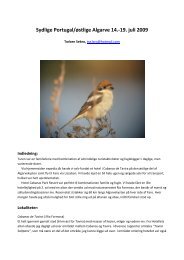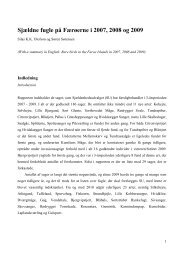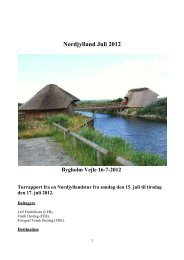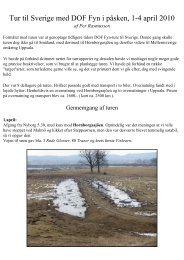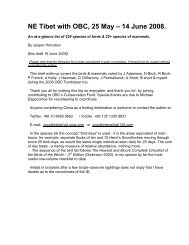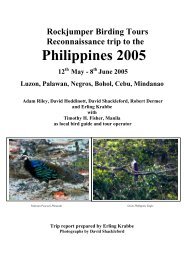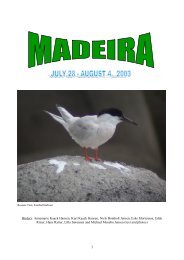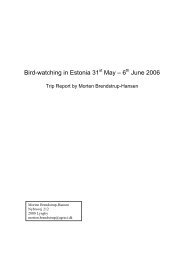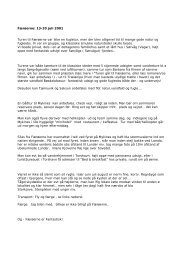TURKEY - a report from a birdwatching trip to Central ... - Netfugl.dk
TURKEY - a report from a birdwatching trip to Central ... - Netfugl.dk
TURKEY - a report from a birdwatching trip to Central ... - Netfugl.dk
Create successful ePaper yourself
Turn your PDF publications into a flip-book with our unique Google optimized e-Paper software.
<strong>to</strong> the south, since left (as noted in Gosney 1991). At a fast brook along road 5, turn south again: the<br />
next km´s along the eastern site of the forest is the main site. "The Picnic Area", described in<br />
Gosney 1991 proved unsuccesfull.<br />
Other areas includes main road leading S <strong>from</strong> main Highway Adana-Gaziantep <strong>to</strong>wards<br />
Yumurtalik (at village of Demirtas) (Grunwell 2005). Observed Birezik May 2006 (Nilsson 2006).<br />
Prefers wooden areas and plantations with well grown canals and wires for lookout post, but kept<br />
well hidden during most of the stay. Not necessarily a wetland bird, as often seen away <strong>from</strong> water<br />
in areas where more widespread, such as in India (own obs.).<br />
153. Pied Kingfisher Ceryle rudis Gråfisker<br />
2005: 21.5 2 fish ponds along River Euphrates S of Birezik - 21.5 1 gravel pits north of Birezik<br />
along west bank of River Euphrates.<br />
2007: 25.5 4 Kiji Restaurant, Birezik.<br />
A species with a southern distribution inTurkey, <strong>to</strong> be looked for even at Halfeti, at Göksu and<br />
Tarsus Deltas and along Tigris along slowly streaming rivers, prefarable with fish ponds.<br />
Population estimated <strong>to</strong> ca. 200 pairs in Turkey (Cramp 1985).<br />
154. European Bee-eater Merops apiaster Biæder<br />
Common and widespread, especially attracted by bee-farming, but regular throughout.<br />
2005: Most 13.5 25 Akgöl, Göksu - 15.5 24 at colony Dorigal - 15.5 20 Kayseri - 16.5 20 Maden<br />
Koprunasi. - 17.5 20 migrating Rize - 17.5 75 migrating Hopa - 18.5 16 Igdir - 19.5 11 Ishak Pasa -<br />
19.5 14 Van hills (of which 11 migrating north) - 19.5 10 Erzek Gölü - 20.5 29 Tatvan - 21.5 20<br />
River Euphrates S of Birezik - 21.5 60 gravel pits N of Birezik along western bank of River<br />
Euphrates (the former locality for Blue-cheeeked Bee-eater,), incl. breeding colony.<br />
2006: Most 17.5 21 Kayseri-Sarkisla - 17.5 25 Sivas – 18.5 42 Erzinzan-Mercan – 21.5 45<br />
Dogubayazit – 22.5 25 Ishak Pasa – 23.5 79 Bitlis-Silman – 23.5 21 Silvan-Diyabakir – 24.5 35<br />
Atatürk Barazi (see Green Bee-eater) – 25.5 15 Birezik. On migration 19.5 9 migrating Kalkandere<br />
– 21.5 17 Ishak Pasa – 22.5 11 Bendimahi Marshes-Van – 23.5 12 Van-Tatvan.<br />
2007: Most 18.5 20 Yoncalic-Maden Köprubasi – 18.5 20 at coloni Maden Köprubasi – 18.5 50 at<br />
coloni Ispir – 20.5 10 Halikisla (incl. breeding pair) – 20.5 17 Tuzluca - 21.5 20 Erzis-Aydinlar –<br />
21.5 30 Bulanik (incl. breeding coloni Rustemgedik) – 22.5 22 Baykan-Batman – 22.5 55 Sucete,<br />
Raman Dagi – 22.5 25 Hasankeyf – 23.5 10 Buzak – 24.5 45 at breeding colony Atatürk Baraji. On<br />
migration 18.5 11 Yoncalic-Maden Köprubasi – 19.5 10 Rize-Hopa<br />
The Turkish population estimated <strong>to</strong> between 10.000 and 100.000 pairs (Tucker & Heath 1994).<br />
155. Blue-cheeked Bee-eater Merops superciliosus Grøn Biæder<br />
2006: 24.5 40 at breeding site Atatürk Baraji (between Adiyaman and Sanli Urfa).<br />
2007: 24.535 at breeding site Atatürk Baraji.<br />
The breeding site at Atatürk Barasi is easily found. 3km west of the road crossing at Atatürk<br />
Barasi, the road crosses the rover Euphrates. 200 m. further <strong>to</strong> the west the birds breeds in a mixed<br />
colony with Bee-eaters in gravel pits. 4 birds here in late April 2007, when the area was disturbed<br />
by sand-digging now (P. ter Heide in e-mail), but colony fully occupied 24.5. The coloni is in a<br />
small, sheltered area away <strong>from</strong> the colony of European Bee-eater.<br />
Formerly bred at Birezik (e.g. >25 birds here in June 1994), but only random observations since<br />
2001,where the habitat at the gravel pits was destructed. In recent years a small breeding colony is<br />
at Estafirulla near Tatvan (3 in 2006). Also breeds east of Igdir: take the road <strong>to</strong>wards Araliki, and<br />
scan the first village (Harrop 1994, Goossens 2006, Highie 2006), and probably along the border <strong>to</strong><br />
Armenia. Found in dry areas with gravel pits and scattered trees, especially near water. Turkish




